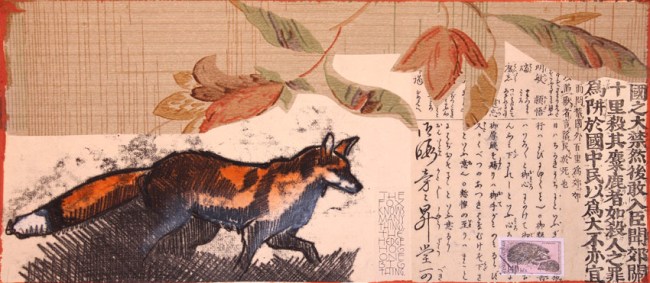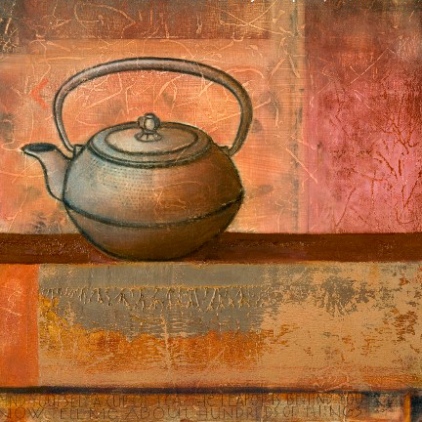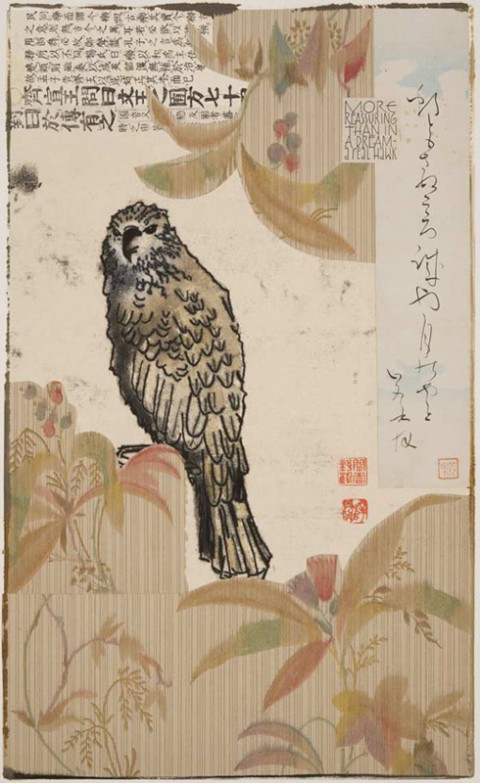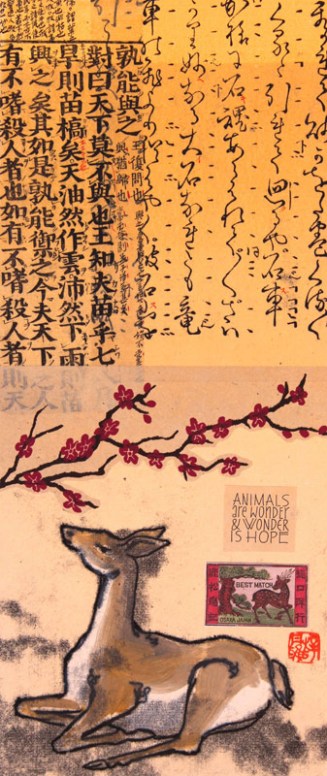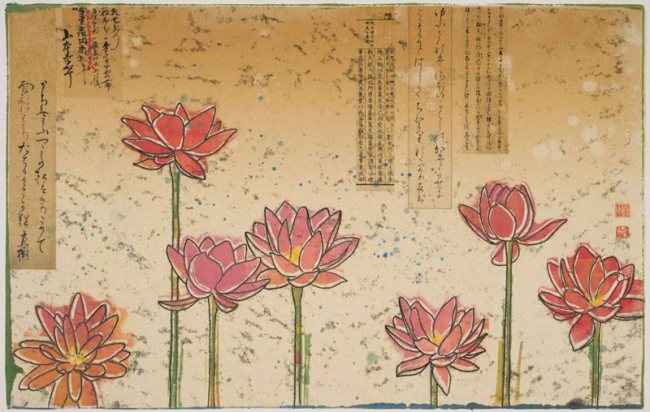Hopefully you’ve had the opportunity to walk into the gallery lately and be welcomed by the vast array of images we have hanging in the front atrium by artist Diana Stetson, calligrapher, printmaker, painter, poet. Let’s welcome the beauty as Diana shares some insights into her work with Kathy Frey.
KF: How would you describe your work and the images and themes you work with?
DS: I’m really committed and connected to beauty. That is my main motivation. It’s really popular right now to be edgy, to confront difficult issues. For me as an artist, I’m not called to that. It’s more the opposite. I don’t want to make work that is pretty. I want to make beautiful work, powerful work.
I had a remarkable childhood. Spending lots of time alone in nature and learning a lot from it. That’s been the biggest part of my work. That connection. Americans have been less connected to nature. We don’t find spiritual peace there as much as other cultures. I’m trying to help people remember that connection and get back to it.
KF: Here in California, we are thinking a lot about Spring since it seems to have arrived early after a rather mild winter. Do you have a favorite season?
DS: I’ve lived all over the world and in almost all the states. In the Hudson River Valley, where I grew up, Spring was my favorite. All the flowers and lush beauty after a harsh winter.
In New Mexico it’s windy. Spring is not the best. Here, Winter is my favorite. It’s a very deep, introspective, quiet time.
KF: What is Spring like in New Mexico?
DS: Spring is still a special time. I have a Spring birthday; I’m an Aries. There’s the Vernal Equinox. I planted a willowy tree in my yard on my birthday one year, and each year the chartreuse green leaves emerge and announce Spring.
I live in Albuquerque. Most people don’t know Albuquerque; they know Santa Fe. People should come here and walk. Albuquerque is beautiful; the Rio Grande runs right through the city. Albuquerque has orchards, vineyards, fields – a whole culture of irrigation – it’s all about water. There are hundreds of irrigation channels; it’s wonderful walking there since there are no cars. They are not beautiful when they are empty, but the water goes into the ditches in March. It’s a big celebration. The water is powerful in this desert environment.
KF: What took you to Albuquerque?
DS: I came here right after college. The spiritual power of the place has kept me here. You feel it when you are here. As an artist, I draw on that.
I don’t paint the actual landscape but rather draw on the deeper spirituality of this place. It’s also like a third world country here. It’s the poorest state in the union, and I can escape from commercialism and the American reality here.
KF: What new things do you have in the works?
DS: I’m still figuring out how to work as an artist and tackle environmental issues on the planet. I’m painting more – I’m developing a new series called “Protecting Place” – about protecting our home, our planet. It’s a big project. I created an elephant image after hearing an elephant hunt story that deeply disturbed me. I have a hawk image that relates to wildlife rescue. There’s a lot to protect. I’m not sure how people will respond to these images.
I want to sink my teeth into this project and work with others since it’s so big. My whole team, including web developers and business people, is about 14 people, and we’re brainstorming how to make an impact.
For the last few years I’ve been painting a lot and writing poetry. The poems go with the paintings. My works on paper, like most of what’s shown at the Mowen Solinsky Gallery, have text on them as part of the image. There’s one painting at the Mowen Solinsky Gallery (“Hundreds of Things,” shown below), and I will send more in time.
Find yourself a cup of tea
The teapot is behind you
Now tell me
About hundreds of things.~ancient Japanese poem
KF: How do you connect with nature and beauty?
DS: I’m working so hard and so seriously. I just started painting large format 2 years ago. It’s been really demanding to juggle it all.
In memories and dreams I have connections with nature. That’s where I’m getting it. So much inside of me is feeding it.
KF: John Mowen describes your work as “the visual reminder of the sacred aspects living in all things.” Can you talk about those sacred aspects?
DS: For me how I can talk about it is through poetry. It’s deeper and to the point.
[note: following the interview are several of Diana’s poems that she shared with us]
Every image that I make is about trying to capture that connection, to the bird, the flower, weather, rain… that interconnection with things that aren’t human. Every image reaches for that deeper connection through spirit. Most artists know they are working for something much bigger, and it’s just coming through us.
KF: What drove you to switch mediums at age 55?
DS: I’ve gone through four distinct periods in my life.
In college I studied lettering very seriously. I was at the only college that covered the history of lettering, and I continued studying in Asia and then in England. I did all that for 20 years.
As an artist you change over time. I started introducing collage into my work, so then I described myself as a collage artist.
In 1990 I started printmaking, which allowed me to combine even more. Printmaking was another 20 year span.
When I would be standing in a museum, what really got me going was original oil paintings. Then I would go back to my studio and do my own work. Eventually I got to the point where I decided to try it. In 2010, I got a private teacher who is a well-known painter. She agreed to take me on because she could tell I was serious.
As soon as I started, she could tell that I was already a painter… we felt I’d always been a painter; it just took me a long time to find my calling. Now I have something to say in my paintings, in my 50s, which maybe I wouldn’t have had to say when I was younger. Maybe there’s a reason I’m finding it now, at this point.
KF: What type of painting are you doing?
DS: I’m focusing on oil on panel. I can get the layering techniques and effects I want. Both of my studios. printmaking and painting, smell the same since they are both oil based, but oil painting is a new medium for me. It’s still an exploration, and it’s still fun for me. Both printmaking and painting energize me; both are powerful.
KF: We currently have your lotus image hanging in the gallery, which is a monotype. Can you explain what “monotype” means?
DS: A monotype is a one of a kind piece made on an etching press. There are no repeatable elements in the piece. It is numbered 1/1. This is it!
Seven Lotus Blossoms
one of a kind monotypeLotus
is not a flower
it is
a pastel light
an ancient gem
a water murmur
an inner world
a translucence
a secret hope
a dreaming
an abiding peace
a distant hum
a cloud at ease
a breath taken.
Lotus
is not a flower
it is a question
and an answer,
a possibility and
an impossibility.
~Lotus is Not a Flower
Diana Stetson
February 2013
For many of my monotypes, I incorporate an original drawing on Japanese paper, often from my collection of vintage papers, to add to the uniqueness of each piece. I find other collage elements and layer them to go through the press. Then I paint on plexiglass and run it through the press with the collage; this gives a different effect than painting directly on paper.
Since this is a monotype, not an etching or other type of print, the text and lettering do not have to be in reverse. I developed a script that’s timeless, with influences from so many eras, from ancient Asian cultures to Frank Lloyd Wright. For a monotype, I can do the lettering directly on the piece or on a piece of paper that becomes part of the collage.
This monotype process comes naturally because it’s built on my skills.
KF: How do you approach your work?
DS: I like working in series, that feeds me. I need to be able to talk about it and release my intention. If I do a drawing I like of a bird, I’ll do another original drawing of the same bird and use it differently. I play with scale, positioning – each drawing is one of a kind but it’s a series.
KF: What do you see in store for the future?
DS: I really have a sense my career is just taking off now. There’s a wider exposure to my work, both nationally and internationally. I’m working larger, and I’m working on bigger issues.
Recently I went to Turkmenistan; I was chosen to represent artists. This experience gave me the feeling that artists are in an amazing position. Turkmenistan is very closed; you can’t even go there with a visa! I was being welcomed as a cultural ambassador.
Artists are the one people who can bridge between cultures; we are peacekeepers. Art is transcending politics and religion.
It was amazing to be the only visual artist, and a woman at that, in this group of ambassadors that included several musicians, a Hopi jeweler, a chef and a group of scholars from the Smithsonian, in this tribal Muslim country. I really got into it and felt like I was really making a difference. I’d love to do more of that and to work more internationally. Being a Cultural Ambassador is where it’s at!
[note: Diana is working on a video about this experience that she will post to YouTube soon. There’s a copy of an article written about this trip available in the Mowen Solinsky Gallery as well.]
Desert Butterflies
In the high desert,
butterflies gather
in places of water,
passing freely
between worlds
to carry messages
between the living
and the spirits of
those gone ahead.
Silently, delicately,
connecting all beings
each to the other and
each to water of life.~Diana Stetson
Migration is Impossible
“Your smooth branches
are paradise
where the butterflies hide.”
~ John Brandi
Weightless bodies
can have no energy.
Energy equals mass
times c squared.
No mass no energy.
No knowledge of
a thousand miles.
No possibilities.
The migration
of monarch
is impossible.
In paradise,
energy comes
from impossibility,
from the colors of
orange and tangerine,
from miniscule drafts
off of the wings of others,
from the smooth branches
of trees along the way,
from water sipped out of
clouds that cheer,
from other butterfly hearts
on the same journey,
from invisible lines
etched in the air
by millions of relatives
over hundreds of years.
The migration
of monarch
is impossible as love,
beautiful as anything.
~ Diana Stetson
March 2013
What did the Hawk Learn?
What does sacred wind say
through feather of hawk?
That beauty arrives
with each breath in
and each breath out?
That there is no truth,
only silver moonlight
behind silken cloud
to comfort us all?White hawk stands
motionlessly on the head
of the Moon Goddess,
the tips of his pointed wings
brushing her ears stiffly.
Who were the ancestors
who lived before the gods?
What did the hawk learn
from the arms of a woman
to be able to speak to the sky?~ Diana Stetson
March 2013
